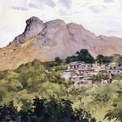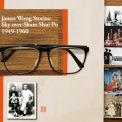Looking at the history of Hong Kong cinema, the influence of Shaw’s was reflected not only in its colossal production volume, but also in its glamorous all-star cast line-up. The Shaw studios adopted a streamline production system which required the support of a large number of performing artists. In order to make this system work, the studio learnt from the Hollywood system and incorporated the techniques of star grooming. The studio selected new faces on a continuous basis and provided them with performance training. In addition, it invoked a publicity mechanism, created unique images and expanded the varieties of roles for its actors, and managed to groom many on-stage and off-stage talents.
Engaging famous actors
Tianyi Film Company (Tianyi for short) was founded in 1925 in Shanghai, where it screened its pioneering work, Repentance. Thereafter, as a result of the needs created by business development and the market, it started to recruit new actors. For instance, in October 1925, Tianyi posted an employment advertisement in Shun Pao to recruit actresses and trainees. In the 1930s, among the most important actresses on whom Tianyi counted were Chen Yu-mei and Wu Su-xin, who starred in The Flirting Scholar (1926), Four Commandments (1926) and other classic films. In addition, Tianyi engaged a number of renowned actors to star in the films it produced. For instance, the famous Beijing Opera diva Fen Ju Hua played the lead lady in Lee Fee-fee the Heroine (1925). This strategy was implemented as a way to boost the attraction of the films and gradually became the standard practice.
Recruiting new actors
In 1934, Tianyi set up a studio in Hong Kong (Tianyi HK Studio for short) During its early phase of operation, Shaw Run-de invited Butterfly Wu to make Cantonese films, including Unworthy of Love (1935), for screening in the Nanyang, Guangdong and Guangxi regions. In order to expand the Cantonese film market, Tianyi HK Studio collaborated, from time to time, with various famous Cantonese opera actors, including Sit Kok-sin, Pak Kui-wing, Sun Ma Si Tsang and the like, to make the films, The White-Golden Dragon (1934), Unworthy of Love (1934), Mourning of the Chaste Tree Flower (1934), etc. As these famous Cantonese opera actors were highly popular with the audience of the Guangzhou, Hong Kong and the Southeast Asian regions, Tianyi HK Studio was therefore able to establish its position in the Cantonese movie circle. To build on this foundation, Tianyi recruited new actors in March 1935. The Hong Kong Industrial and Business Daily at the time reported, “Tianyi Film Company Hong Kong posted actor-recruiting advertisements in various newspaper, and got a very enthusiastic response, with about 1200 people applying …” This was an evidence of how great the response was.
While Shaw Brothers were striving to open up new business opportunities in the new market of Hong Kong, fires broke out repeatedly at Tianyi HK Studio, greatly affecting Shaw’s progress. Shaw Run-de then came to Hong Kong to manage the studio in 1937. He changed the name of the studio to Nanyang Film Company (Nanyang for short) and started running cinemas. Also, he expanded the filming facilities on Pak Tai Street by adding one more studio to the existing two, which enabled the studio to focus more on making Cantonese films. On the actor-recruitment front, Nanyang invited quite a number of famous Cantonese opera actors to star in the films it produced. An example was the appearance of Pak Kui-wing in The humiliation of the rickshaw (1938). Many Cantonese film actors, such as Yee Chau-shui and others, also performed in Nanyang’s films. This could be deemed as a continuation of the strategy used in the period of Shao Zui-weng of recruiting Cantonese film actors to expand the Cantonese film market.
The Making of Stars
In the 1940s, Shaw Run-de restructured his film production business time and again, and in 1952, he founded Shaws & Sons Ltd. At the time, many film personalities from Shanghai moved southward to settle in Hong Kong. Besides committing itself in the Cantonese film business, Shaws & Sons also tried to develop the Mandarin film market by enlisting film personalities from the north like Li li-hua, Yan Jun, Zhou Man-hua, Bai Guang and Huang He. They appeared in Mandarin films such as Blooming Roses (1952), A Double-faced Man (1952), Midsummer Night’s Romance (1953) and Sorrowful Glory (1953), which were all very popular.
In 1958, Shaw Brothers (Hong Kong) Limited (Shaw’s for short) was inaugurated, aiming to expand its Hong Kong production business on a grand scale. To meet the requirement of the intensive streamline production of the studios and the soaring need for actors, Shaw Run-run not only engaged the film personalities from the north (like Li li-hua, Yan Jun, etc.), but also recruited talents from other film companies, with Peter Chen Ho, Linda Lin Dai, Betty Loh Ti and others joining Shaw’s as a result. In addition to using existing talents, Shaw’s was committed to the training of new faces to broaden the supply of actors.
By the late-1950s and early-1960s, Shaw’s had already set up a system for recruiting new talents to support its streamline studio production and to provide a continual supply of on-stage and off-stage personnel. All aspects of the system – from recruiting procedures, interviews to the training offered to the trainees – were becoming systematic. An example was the Southern Experimental Theatre Company, which was established in September 1961 and was renamed the Southern Acting Training Class subsequently. The Company invited senior filmmaker Ku Wen-chung to act as its head and gradually introduced training courses with more established scopes. For instance, the Company was divided into Mandarin and Cantonese sections; and course curriculum included the basics such as postures, sensations, articulation, singing and dancing, as well as more technical and advanced topics such as on-set training, make-up, stage-setting, and theory on lighting. There were over 40 trainees in the first intake of the class, and they prepared for their future performance by rehearsing operas, dance dramas, Huangmei operas, radio dramas, etc., in groups. Later, the Southern Experimental Theatre Company became a permanent fixture and recruited actors every half a year. It served to provide a stream of promising new faces for Shaw’s to support its studio production.
Keen Competition and the Establishment of the Star System
In the 1950s and 1960s, as the competition among film companies were getting keener, the film market war-zone was also extended to cover the segment of “star-making”. At the height of its studio production, Shaw’s fetched and kept promising talents through long-term contracts. It also learned from the Hollywood-style “star system” and instigated the publicity mechanism to turn its actors into movie stars of the silver screen. Through long-term contracts, the studio was guaranteed with a constant supply of actors, and was hence better able to mobilize actors to fit the streamline production process. In addition, Shaw’s set up the “Shaw’s Movie Fan Club” to band together the supporters for its stars. According to the “Southern Screen”, “after organizing and studying the possibility for some time, “Shaw’s Movie Fan Club” was finally established recently. Breaking the barrier of communication between the stars and the movie fans and thus facilitating the growth of their affection and interaction are the aims of setting up the “Movie Fan Club”…The interaction between Shaw’s and the movie fans was also on the increase. The company received mountains of letters from the movie fans, and in many of the letters, requests for Shaw’s to set up a sort of movie fans club were expressed. Hence, the establishment of “Shaw’s Movie Fan Club” was in a way brought about by the movie fans.”
In fact, the intensive production of the studio was effective in increasing the exposure and the popularity of the stars. Through Shaw’s distribution network in the Southeast Asian region, supplemented by the publicity created by the official publications, the images of the stars were deeply engraved in the hearts of the audience. Betty Loh Ti and Linda Lin Dai, for instance, became the female stars of a generation, signaling the glamorous stardom of the golden era of the studio system.







